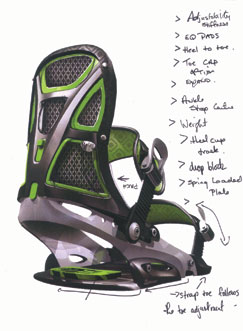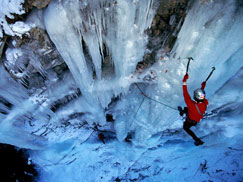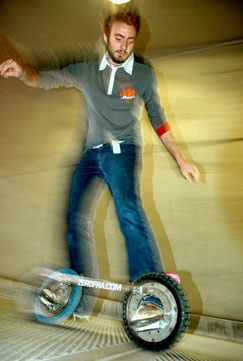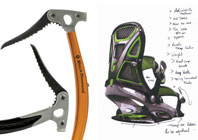Strapped in

Option Snowboards’ designers use concept sketches before proceeding to 2D AutoCAD
and 3D modelling in SolidWorks
Gliding down powder-covered slopes gives a feeling of freedom like no other, but ironically requires that the rider is strapped tight to the board via cutting edge bindings technology.
Option snowboards are based in Vancouver, Canada, and have been producing boards and bindings since 1992, winning awards and X-Game gold medals ever since. Their 2009-10 bindings incorporate lightweight design, comfortable fit along with technology like the base plate shaped to allow for a natural board flex underfoot.
Option Snowboards engineering and design manager Jason Kennett explains that the designers produced hand sketches, before his team proceeded to 2D AutoCAD and 3D modelling in SolidWorks.
“Our production factory in Asia uses Pro/Engineer, so they basically re-modelled the binding in that program to produce tooling,” he says. “A few SLA prototypes were made to confirm some details, and then prototypes were produced with production materials to validate weight and mechanical properties. Finally production tooling was produced.
“Trying to maintain the look and feel of the designer’s concepts through two separate modelling processes was a pain in the ass,” concludes Jason, having admitted that in the short timescale to get the bindings into production they had already designed them before selecting the production facility.
The end product is a quickly adjustable piece of kit with a high back to aid forward lean and the high back attachment outboard of the heel cup to allow for a better fit inside the boot, amongst a litany of other features to give you control when you get onto the slopes.
Gripping stuff
Activities require the right equipment. Sunday afternoons at home require a hot cup of tea, a selection of biscuits, and most importantly the Antiques Roadshow. But when you’re gripping on for grim life through howling winds and freezing temperatures, to an ice-face that could collapse at any second, you’re going to need something a tad more secure.

For the design of its Cobra and Viper products stainless steel spikes were used in combination with vibration dampening carbon fibre shafts to keep the majority of the tool’s weight in the head
Black Diamond is a tried and trusted name when it comes to ice climbing, with the company’s designs taking into account not just the conditions facing the axes, but also the person clinging to them.
“The big concept was to seamlessly blend form and function,” says Black Diamond designer Paul Terry. “They had to be sexy and perform flawlessly.”
The Cobra’s inspiration is its namesake, the shaft echoes the hood of the snake, and the grip the belly scales, maintaining function through an incredibly stiff upper shaft, while the directional grip is comfortable and, like the Viper, is designed to be less fatiguing when hanging.
For the design process, an engineering ‘mule’ with all the critical geometry is created in Unigraphics NX. Then hand sketches and digital sketches are made in Alias Studio and Photoshop before being modelled and surfaced in Alias Studio. NX Nastran is used extensively throughout for strength testing.
“These designs wouldn’t have been possible without the digital tools we used,” explains Paul. “The information available at every step is a key part of truly removing the line between form and function.”
www.bdel.com
Its all downhill from here

“I wanted to invent a summer snowboard with the possibility to use it over different surfaces” Franz Sommacal
For those of us whose only view of snow will be the grey slush clogging the gutters as we sit blocked in traffic, there’s hope that we can still experience the weaving, adrenaline peaking experience of snowboarding thanks to the 360 from Franz Sommacal.
“The concept was to create a new action and extreme sport like snowboarding, surfing or skateboarding,” says Franz. “I wanted to invent a summer snowboard with the possibility to use it over different surfaces.”
The wheels are connected using a flexible shaft, with the rider placing their feet into the inner part of the wheels, resulting in a sensation closer to snowboarding.
The product of four months of constant R&D, the original idea is a product of ‘off piste’ activities. “I remember that I was playing with an orbital wheel from a skateboard on the table between the beer glasses… The form was a natural consequence of the materials, mathematics and physics of the object.”
Built up using Alias, SolidWorks and using Maxwell Render for light simulation, Franz admits that the product will need to take advantage of strength testing software if it ever finds a funding partner to help make this ‘winter sport’ a reality for those not so blessed with snow.
www.zerofra.com

We strap ourselves in for some winter sports, and a non-snow alternative






